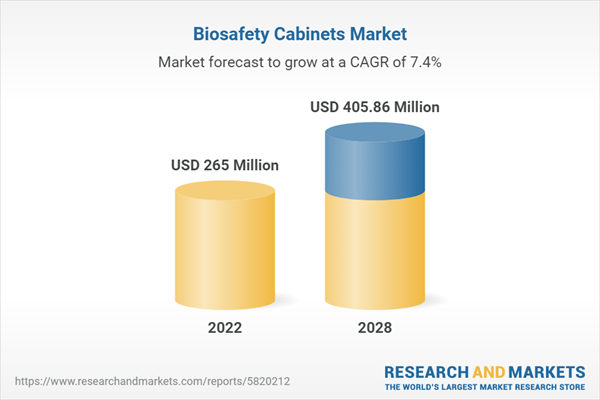Speak directly to the analyst to clarify any post sales queries you may have.
MARKET TRENDS & DRIVERS
The Growth in Technological Advancements
With huge advancements in the technology sector, the biosafety cabinet market is also being integrated with technologies that can help detect any leakages or failures of any part of the cabinets. Over the past years, there have been huge developments in the technological integration with these biosafety cabinets. Technological developments such as HEPA filtration systems can filter out 99.9% of the contaminants in the air. These systems have also been integrated with IOT, such as automotive systems shut down and alarm systems that will raise alarms if these systems observe any malfunction or failure of the exhaust systems.Increased Risk of Communal Diseases
The world has recently witnessed the catastrophe that communicable diseases can cause through the Covid-19 virus. A disease that can be spread from one person to another through various ways, including contact with another person’s blood and bodily fluids or breathing in airborne viruses, and being bitten by an insect carrying the pathogen or virus is called a communicable or infectious disease. These diseases can have a variety of severity ranging from asymptomatic (no symptoms) to severe to fatal. Some examples of communicable diseases are HIV, hepatitis A, B, and C, measles, salmonella, and blood-borne diseases. The biosafety cabinets are used in laboratories to study the organisms that transmit such diseases and could be the cause of the spread of communal diseases. Since these pathogens are infectious and can easily spread, utmost care must be taken to handle them. Hence biosafety cabinets are a must in such cases. These cabinets also allow the researchers to analyze the functioning and the process of infection that these organisms inflict.Development in Biological Testing
The world is currently moving towards modernization and an advanced technological era. These advancements in technology have allowed chemical, biological, and microbiological testing. Further, these tests are conducted to understand and conduct analysis or research on the parameters of a product/subject. The subject in biological testing can be a human, dead or alive, animals and birds. Growing importance is given to biological testing as it is crucial in the early and timely diagnostics of infectious diseases and helps properly manage patients. Biological testing is carried out with substances that can harm the environment and humans, which can also potentially cause infections among them. Hence, such reasons are driving the growth of biological testing facilities across the globe, which will positively impact the biosafety cabinet market as they would be an integral part of the laboratories handling such samples.SEGMENTATION INSIGHTS
INSIGHTS BY PRODUCT TYPE
The biosafety cabinets or biological safety cabinets are of three major types Class I, II, III. They are assigned to various classes based on the level of safety and protection offered and the level of biosafety measures it can operate. Class II is further sub-segmented into five subcategories. The sub-segments have advanced features such as HEPA filtration systems; they regulate airflow pressure and are safer than class I biosafety cabinets. Class II held most of the global biosafety cabinet market share as they are versatile and used across most facilities.Segmentation by Product Type
- Class I
- Class II
- Class II A1
- Class II A2
- Class II B1
- Class II B2
- Class II C1
- Class III
INSIGHTS BY END-USER
The global biological safety cabinet market is driven by the safety requirement when handling hazardous substances across various sectors, such as pharmaceutical and biopharmaceuticals, academic research institutes, and diagnostic laboratories. The biosafety cabinets play a critical role in these sectors, enabling them to carry out tests and procedures without contamination. Research institutes are of two types private and university. Both play a very important role in finding new drug compositions and new techniques for diagnostic purposes for various diseases. Pharmaceutical and biopharmaceutical sectors had the majority share of the global biosafety cabinet market, accounting for over 53%. The biotechnology sector is propelling the industry’s growth as it is heavily involved with researching and developing therapeutic proteins and drugs through genetic engineering. This sector is important for integrating biology and technology to change or improve a component, or entire biological system, which can benefit human welfare or the industry.Segmentation by End-User
- Pharmaceutical & Biopharmaceutical Companies
- Diagnostic Laboratories
- Academic Research Institutes
INSIGHTS BY DISTRIBUTION CHANNEL
The global biosafety cabinet market by distribution channels segments as online and offline. The offline method is one of the oldest techniques that are in existence that is utilized to get a company’s products to their potential customer. In 2022, the offline distribution channel had the highest global biosafety cabinet market share. Factors such as broader reach in areas that lack better connectivity and high consumer trust associated with touching and experiencing the quality of products are driving the growth of this segment. Further, the online distribution channel allows manufacturers and vendors to have multichannel campaigns across various channels, such as third-party retailers and direct websites. Online shopping entails online buying, mobile ordering, and digital media. High penetration rates of connectivity are expected to grow the online multichannel platforms' visibility during the forecasted period, thus increasing the online presence of the vendors.Segmentation by Distribution Channel
- Offline
- Online
GEOGRAPHICAL ANALYSIS
North America holds the largest global biosafety cabinet market share, accounting for over 38% in 2022. The market is majorly driven by the presence of pharmaceutical, research, and development institutes and laboratories for diagnostic purposes. The region of North America majorly consists of developed countries, and the U.S. is the major contributor to their economy. According to Torreya, in 2020, U.S pharmaceutical companies raised USD 120.3 billion in Initial Public Offering, the highest in recent years. Such reasons are projected to propel the growth of biosafety cabinets in the region during the forecasted period.Segmentation by Geography
- North America
- The U.S.
- Canada
- Europe
- Germany
- The U.K.
- France
- Italy
- Spain
- APAC
- China
- Japan
- India
- Australia
- Middle East & Africa
- Saudi Arabia
- South Africa
- UAE
- Latin America
- Brazil
- Mexico
COMPETITIVE LANDSCAPE
The global biosafety cabinet market needs to be more cohesive and have many national and international participants. These players have been continuously focusing on innovation and product differentiation techniques. They also rely on these factors to capture higher market shares. It is also expected that with more favorable financial and technological capabilities will be able to invent and launch products that are technologically integrated, which might threaten the products of their competitors and could make their products and services non-competitive.Key Company Profiles
- Thermo Fisher
- Kewaunee Scientific
- Esco Lifesciences Group
Other Prominent Vendors
- The Baker Company
- Azbil Group
- NuAire
- Labconco
- Germfree Laboratories
- Cruma
- Suzhou Antai Airtech Co Ltd
- Qingdao Haier Biomedical
- Air Science
- Berner International
- Contained Air Solutions
- Bioevopeak
- Photon Cleantech Inc
KEY QUESTIONS ANSWERED:
1. How big is the biosafety cabinet market?2. What is the growth rate of the global biosafety cabinet market?
3. Which region dominates the global biosafety cabinet market share?
4. What are the significant trends in the biosafety cabinet market?
5. Who are the key players in the global biosafety cabinet market?
Table of Contents
Companies Mentioned
- Thermo Fisher
- Kewaunee Scientific
- Esco Lifesciences Group
- The Baker Company
- Azbil Group
- NuAire
- Labconco
- Germfree Laboratories
- Cruma
- Suzhou Antai Airtech Co Ltd
- Qingdao Haier Biomedical
- Air Science
- Berner International
- Contained Air Solutions
- Bioevopeak
- Photon Cleantech Inc
Methodology
Our research comprises a mix of primary and secondary research. The secondary research sources that are typically referred to include, but are not limited to, company websites, annual reports, financial reports, company pipeline charts, broker reports, investor presentations and SEC filings, journals and conferences, internal proprietary databases, news articles, press releases, and webcasts specific to the companies operating in any given market.
Primary research involves email interactions with the industry participants across major geographies. The participants who typically take part in such a process include, but are not limited to, CEOs, VPs, business development managers, market intelligence managers, and national sales managers. We primarily rely on internal research work and internal databases that we have populated over the years. We cross-verify our secondary research findings with the primary respondents participating in the study.

LOADING...
Table Information
| Report Attribute | Details |
|---|---|
| No. of Pages | 232 |
| Published | July 2023 |
| Forecast Period | 2022 - 2028 |
| Estimated Market Value ( USD | $ 265 Million |
| Forecasted Market Value ( USD | $ 405.86 Million |
| Compound Annual Growth Rate | 7.3% |
| Regions Covered | Global |
| No. of Companies Mentioned | 16 |









